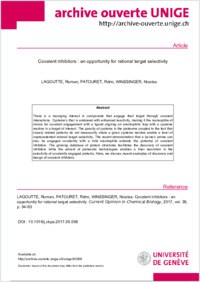Covalent inhibitors: an opportunity for rational target selectivity.
- Lagoutte R Faculty of Science, Department of Organic Chemistry, NCCR Chemical Biology, University of Geneva, 30 quai Ernest Ansermet, CH-1205 Geneva, Switzerland.
- Patouret R Faculty of Science, Department of Organic Chemistry, NCCR Chemical Biology, University of Geneva, 30 quai Ernest Ansermet, CH-1205 Geneva, Switzerland.
- Winssinger N Faculty of Science, Department of Organic Chemistry, NCCR Chemical Biology, University of Geneva, 30 quai Ernest Ansermet, CH-1205 Geneva, Switzerland. Electronic address: nicolas.winssinger@unige.com.
- 2017-06-14
Published in:
- Current opinion in chemical biology. - 2017
English
There is a resurging interest in compounds that engage their target through covalent interactions. Cysteine's thiol is endowed with enhanced reactivity, making it the nucleophile of choice for covalent engagement with a ligand aligning an electrophilic trap with a cysteine residue in a target of interest. The paucity of cysteine in the proteome coupled to the fact that closely related proteins do not necessarily share a given cysteine residue enable a level of unprecedented rational target selectivity. The recent demonstration that a lysine's amine can also be engaged covalently with a mild electrophile extends the potential of covalent inhibitors. The growing database of protein structures facilitates the discovery of covalent inhibitors while the advent of proteomic technologies enables a finer resolution in the selectivity of covalently engaged proteins. Here, we discuss recent examples of discovery and design of covalent inhibitors.
- Language
-
- English
- Open access status
- green
- Identifiers
-
- DOI 10.1016/j.cbpa.2017.05.008
- PMID 28609675
- Persistent URL
- https://sonar.ch/global/documents/76676
Statistics
Document views: 3
File downloads:
- fulltext.pdf: 0
